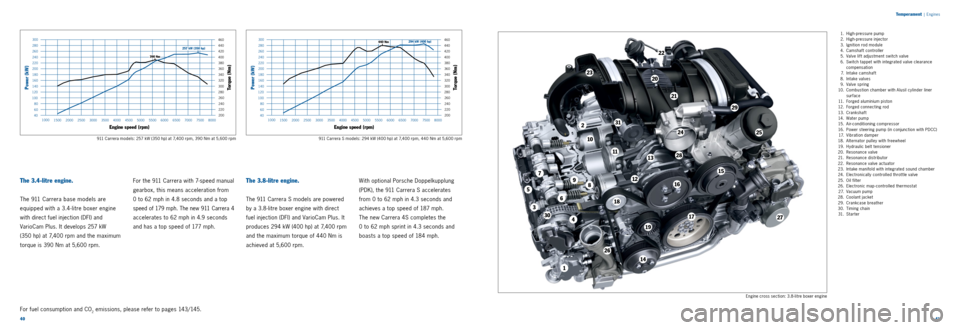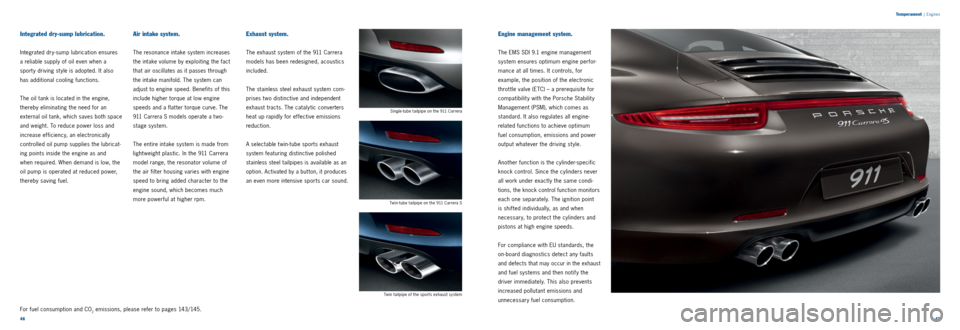oil filter PORSCHE 911 CARRERA 2013 6.G Information Manual
[x] Cancel search | Manufacturer: PORSCHE, Model Year: 2013, Model line: 911 CARRERA, Model: PORSCHE 911 CARRERA 2013 6.GPages: 76, PDF Size: 11.32 MB
Page 21 of 76

1
2
3
4
5
6
7
89
10
11
12
13
14
15
16
17
18
19
20
21
22
23
2425
26
27
28
29
30
31
4041
Temperament
|
Engines
Engine cross section: 3.8 litre boxer engine
911 Carrera S models: 294 kW (400 hp) at 7,400 rpm, 440 Nm at 5,600 rpm
1. High pressure pump
2. High pressure injector
3. Ignition rod module
4. Camshaft controller
5. Valve lif t adjustment switch valve
6. Switch tappet with integrated valve clearance
compensation
7. Intake camshaf t
8. Intake valves
9. Valve spring
10. Combustion chamber with Alusil cylinder liner
surface
11. Forged aluminium piston
12. Forged connecting rod
13. Crankshaft
14. Water pump
15. Air conditioning compressor
16. Power steering pump (in conjunction with PDCC)
17. Vibration damper
18. Alternator pulley with freewheel
19. Hydraulic belt tensioner
20. Resonance valve
21. Resonance distributor
22. Resonance valve actuator
23. Intake manifold with integrated sound chamber
24. Electronically controlled throttle valve
25. Oil filter
26. Electronic map controlled thermostat
27. Vacuum pump
28. Coolant jacket
29. Crankcase breather
30. Timing chain
31. S t a r t e r
911 Carrera models: 257 kW (350 hp) at 7,400 rpm, 390 Nm at 5,600 rpm
The 3.4-litre engine.
The 911 Carrera base models are
equipped with a 3.4 litre boxer engine
with direct fuel injection (DFI) and
VarioCam Plus. It develops 257 kW
(350 hp) at 7,400 rpm and the maximum
torque is 390 Nm at 5,600 rpm. For the 911 Carrera with 7
speed manual
gearbox, this means acceleration from
0 to 62 mph in 4.8 seconds and a top
speed of 179 mph. The new 911 Carrera 4
accelerates to 62 mph in 4.9 seconds
and has a top speed of 177 mph.
For fuel consumption and CO
2 emissions, please refer to pages 143/145.
40 60 80
100
120 140 160 180 200 220 240 260
1500 75008000
2000 2500300035004000450050005500600065007000
1000
294 kW (400 hp)440 Nm
300
280
Power (kW)
T orque (Nm)
Engine speed (rpm)
200
280 300 320 340 360 380 400 420
220 240 260
460
44040
60 80
100
120 140 160 180 200 220 240 260
1500 75008000
2000 2500300035004000450050005500600065007000
1000
300
280
Power (kW)
T orque (Nm)
Engine speed (rpm)
200
280 300 320 340 360 380 400 420
220 240 260
460
440
257 kW (350 hp)
390 Nm
The 3.8-litre engine.
The 911 Carrera S models are powered
by a 3.8
litre boxer engine with direct
fuel injection (DFI) and VarioCam Plus. It
produces 294 kW (400 hp) at 7,400 rpm
and the maximum torque of 440 Nm is
achieved at 5,600 rpm. With optional Porsche Doppelkupplung
(PDK), the 911 Carrera S accelerates
from 0 to 62 mph in 4.3 seconds and
achieves a top speed of 187 mph.
The new Carrera 4S completes the
0 to 62 mph sprint in 4.3 seconds and
boasts a top speed of 184 mph.
Page 24 of 76

4647
Temperament
|
Engines
Integrated dry-sump lubrication.
Integrated dr y sump lubrication ensures
a reliable supply of oil even when a
sport y driving st yle is adopted. It also
has additional cooling functions.
The oil tank is located in the engine,
thereby eliminating the need for an
external oil tank, which saves both space
and weight. To reduce power loss and
increase efficiency, an electronically
controlled oil pump supplies the lubricat
ing points inside the engine as and
when required. When demand is low, the
oil pump is operated at reduced power,
thereby saving fuel.
Air intake system.
The resonance intake system increases
the intake volume by exploiting the fact
that air oscillates as it passes through
the intake manifold. The system can
adjust to engine speed. Benefits of this
include higher torque at low engine
speeds and a flat ter torque curve.
The
9 11 Carrera S models operate a t wo
stage
system.
The entire intake system is made from
light weight plastic. In the 9 11 Carrera
model range, the resonator volume of
the air filter housing varies with engine
speed to bring added character to the
engine sound, which becomes much
more powerful at higher rpm.
Exhaust system.
The exhaust system of the 911 Carrera
models has been redesigned, acoustics
included.
The stainless steel exhaust system com
prises t wo distinctive and independent
exhaust tracts. The cataly tic converters
heat up rapidly for effective emissions
reduction.
A selectable t win tube sports exhaust
system featuring distinctive polished
stainless steel tailpipes is available as an
option. Activated by a but ton, it produces
an even more intensive sports car sound.
Engine management system.
The EMS SDI 9.1 engine management
system ensures optimum engine perfor
mance at all times. It controls, for
example, the position of the electronic
throt tle valve (ETC) – a prerequisite for
compati bility with the Porsche Stability
Management (PSM), which comes as
standard. It also regulates all engine
related functions to achieve optimum
fuel consumption, emissions and power
output whatever the driving st yle.
Another function is the cylinder specific
knock control. Since the cylinders never
all work under exactly the same condi
tions, the knock control function monitors
each one separately. The ignition point
is shifted individually, as and when
necessary, to protect the cylinders and
pistons at high engine speeds.
For compliance with EU standards, the
on board diagnostics detect any faults
and defects that may occur in the exhaust
and fuel systems and then notify the
driver immediately. This also prevents
increased pollutant emissions and
unnecessary fuel consumption.
Twin tailpipe of the sports exhaust system Single
tube tailpipe on the 911 Carrera
Twin tube tailpipe on the 911 Carrera S
For fuel consumption and CO2 emissions, please refer to pages 143/145.